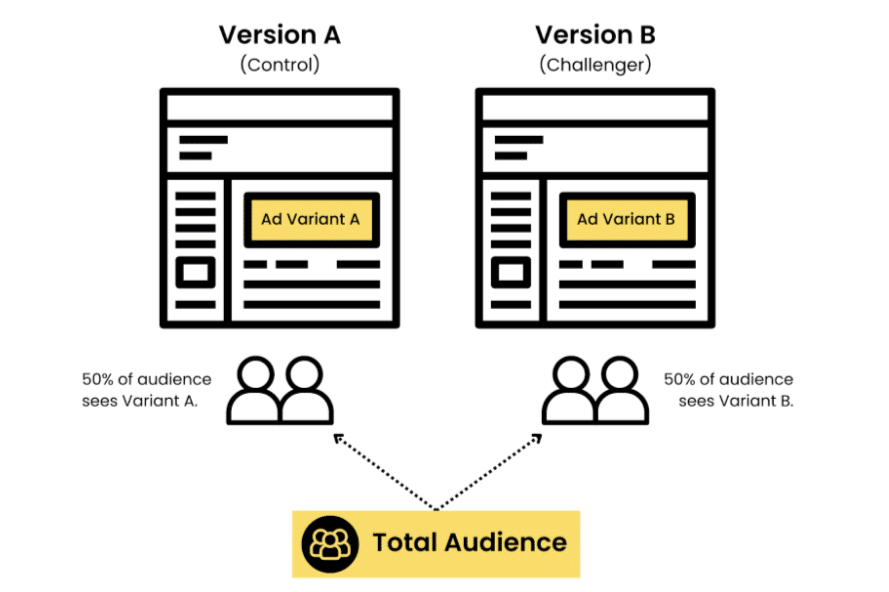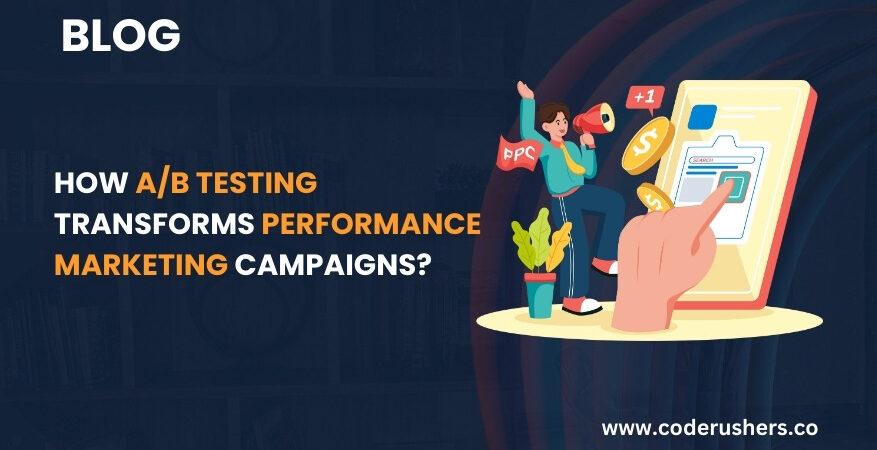What if I told you that something as small as changing the headline of your ad copy or writing a bolder CTA button with a catchy colour could spike your conversions? It might sound too good to be true, but this is exactly what happens when you use A/B Testing in Performance Marketing campaigns.
Take the example of Big Brands. They don’t rely on gut feelings. They leverage marketing A/B testing techniques to fine-tune their campaigns. Everything, from ad creatives and email subject lines to landing pages and call-to-action buttons, is tested, measured, and improved to get the highest ROI.
In this blog, we’ll break down the why, what, and how of A/B testing, showing you exactly how to use this weapon to turn your marketing campaigns into high-performing, money-making machines.
Why Even the Best Marketers Rely On A/B Testing For Higher Conversions?

A/B testing, also known as split testing helps marketers make data-driven decisions. It is the process of comparing two versions of a marketing asset such as an advertisement, email, landing page, or even a social media post and analysing which one will give better results, version A or version B.
Instead of making random changes and hoping for the best, optimizing ads through A/B testing
gives you a scientific way to determine what resonates most with your audience.
Let’s take an example: A company running email testing might compare two subject lines:
- Version A: “Exclusive Offer – Get 20% Off Today Only”
- Version B: “Your Special Discount Inside – Open Now”
By tracking open rates and conversions, they can determine which subject line performs better than the other and use it in future campaigns.
Why Is A/B Testing In Campaigns Important?
You wouldn’t buy a pair of shoes without trying them on, right? So, how can you blindly trust that your campaign will workout without testing it? A/B testing is your trial run! It shows you what fits, what flops, and what drives real results. Without it, you’re just hoping for success instead of ensuring it. Here’s why A/B testing should be your first priority:
Eliminates Guesswork:
Instead of making assumptions about what will work and what not, you get actual data that reveals what works the best and drives engagement and conversions.
Spots High-performing elements:
A/B testing helps you spot those tiny optimizations whether headline or cta that lead to massive improvements in conversions, clicks, and engagement.
Reduces Wasted Spend:
Not a single penny is wasted when split testing ensures that every dollar you spend is working harder by identifying which ad variations, landing pages, or emails are actually bringing results.
Enhances User Experience:
By testing different copy, designs, and offers, you get to know what resonates most with your audience, leading to stronger engagement and deeper connections.
What Elements in A/B Testing Are Game Changers?

- Headlines and Copy: The words you choose influence how people perceive your message. A slight change in tone, urgency, or phrasing can make a massive difference.
- Call-to-Action (CTA) Buttons: The size, colour, and text of a CTA can significantly impact whether users click through or ignore your offer.
- Images and Design: Visual elements create emotional responses that can either increase or decrease engagement.
- Page Layout and Structure: Where you place your CTA, testimonials, or product descriptions can determine how effectively users navigate and convert.
Real-World Example: How Amazon Uses A/B Testing to Dominate E-Commerce
Amazon is one of the biggest advocates of A/B testing. They have made effective testing strategies that rely on continuously testing everything, from product descriptions to checkout button placements. A famous example was when they changed their “Add to Cart” button colour, leading to a measurable increase in sales.
Why? Because small design elements influence user decisions more than we realize. This same principle applies to optimizing ads through A/B testing, it’s about fine-tuning the details that create major results.
Step-by-Step Guide To Marketing A/B Testing Techniques

A/B Testing in Performance Marketing isn’t just about changing a headline or making a button a different colour. It’s about figuring out what actually works and why. You have to make smart, data-backed decisions that drive real results. If you want your campaign to be worthed then check out the effective testing strategies given below:
Step 1: Define a Clear Goal
Before you jump into testing, ask yourself: What exactly are you trying to improve? You can’t just test random elements for fun, you need a specific goal tied to a measurable metric.
Set clear A/B testing goals:
- Increase conversion rate on a landing page
- Boost email open rates by testing subject lines
- Improve ad click-through rate (CTR) by testing images or copy
- Reduce cart abandonment on an eCommerce site
What NOT to do:
- Running tests just to “see what happens” (this wastes time and resources)
- Testing too many elements at once (you won’t know what caused the change)
Step 2: Choose One Variable to Test
This is where a lot of marketers go wrong. If you change multiple elements at the same time, like your headline, CTA, and images all at once then you’ll have no clue which change actually influenced the result.
How should you test:
- Headlines & Copy: Does a question-based headline perform better than a statement?
- Call-to-Action (CTA) Buttons: Check whether “Get Started” converts better than “Try for Free”?
- Ad Variations: Which version of your ad gets more clicks? A person in the image or a product close-up?
- Email testing: Does a casual tone work better than a formal one?
What NOT to do:
- Testing multiple variables at once (e.g., changing CTA, image, and headline together)
- Making small, irrelevant changes (e.g., switching from dark blue to slightly darker blue)
Step 3: Use the Right A/B Testing Tools
You don’t have to track everything manually when there are powerful A/B testing platforms that do the heavy lifting for you. These tools split your audience automatically, track real-time performance, and ensure accurate split test results.
What are the Best A/B testing platforms:
- Google Optimize: Best for testing landing pages.
- Optimizely: Great for advanced experimentation.
- VWO (Visual Website Optimizer): User-friendly and powerful for conversion rate testing.
- Facebook A/B Testing: Ideal for ad variations and audience testing.
- Mailchimp A/B Testing: Perfect for email testing.
What NOT to do:
- Running a test without any tracking tool (you won’t get reliable data)
- Ignoring real-time performance marketing metrics (small changes in behaviour can signal big insights)
Step 4: Split Your Audience Fairly

To get accurate results, your test needs to be split evenly between your variations. If one group gets more exposure than the other, your test results will be skewed and unreliable.
- 50% of your audience sees Version A
- 50% of your audience sees Version B
Best practices for fair split testing in campaigns:
- Ensure traffic is divided randomly and equally.
- Run the test on a large enough audience to get meaningful results.
- If testing ads, make sure both versions have equal budgets.
Step 5: Let the Test Run Long Enough
A lot of marketers panic and stop their tests too soon. Be patient, if you only run your test for a day or two, your data is likely inaccurate and misleading.
How long should you run an A/B test?
- Emails: At least 3-5 days (so you capture different time zones and behaviors)
- Landing pages & ads: At least 2 weeks (to get a balanced data set)
- Website changes: At least 4 weeks (to track long-term performance shifts)
Step 6: Analyze the Data
Now comes the exciting part, reviewing your split test results with performance marketing data analytics. But be careful, because not all metrics actually matter.
Key metrics to focus on:
- Conversion rate testing: How many people took the desired action?
- Click-Through Rate (CTR): Did more people engage with Version A or B?
- Bounce Rate: Did visitors leave faster on one version?
Step 7: Implement the Winner and Keep Testing
Once you’ve found a clear winner, it’s time to scale it across your campaigns. But don’t stop there, continuously testing the performance of your campaign is the only way to keep your brand ahead.
How to keep improving:
- Use the winning version as your new control and test against it
- Keep testing new elements (different CTA text, pricing structures, checkout flows)
- Optimize for different audiences (what works for one group may not work for another)
What NOT to do:
- Thinking A/B testing is a one-time thing (marketing is always evolving)
- Forgetting to test again if your audience or market changes
Final Thoughts!
A/B Testing in Performance Marketing isn’t just an option, it’s a necessity for brands that want to maximize their marketing potential. The difference between guessing and growing comes down to how well you test, analyze, and optimize your campaigns.
Key takeaways:
- Never rely on assumptions, let data guide your decisions.
- Every small change can have a massive impact on conversions.
- A/B testing should be an ongoing process, not a one-time task.
If you want to make your campaigns successful then let Code Rushers do the finest A/B testing for higher conversions!
Make success hassle-free. Contact us Now!

